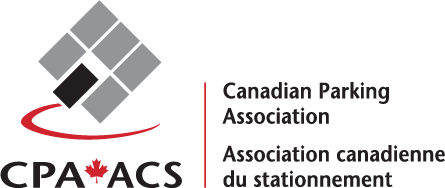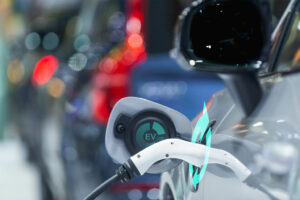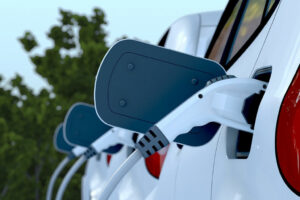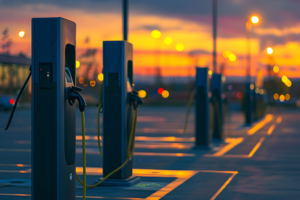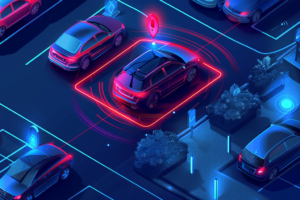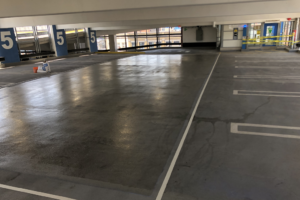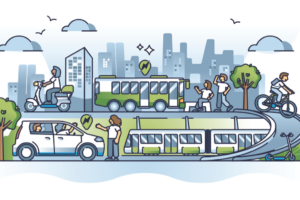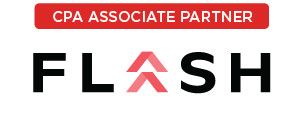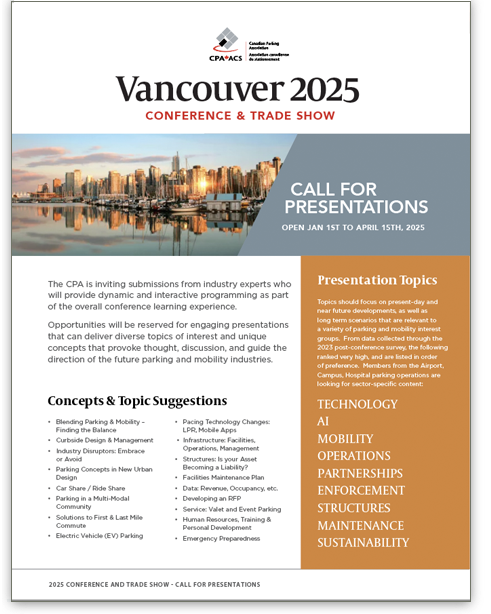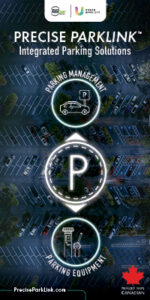By Chris Scheppmann
The proliferation of parking guidance technology has arguably been the most important parking technology trend over the past ten years. The past decade has seen guidance evolve from a valuable tool that many owners considered a luxury to an essential element of parking management. And with maturation of the smart city movement and the introduction of smart city platforms like the Park Detroit app, parking guidance has emerged as the indispensable parking and mobility technology.
Until recently, parking owners were faced with a significant cost/benefit tradeoff when selecting parking guidance technology. There were only two options: expensive single space sensor systems or inexpensive in-motion loop systems. For years, the single space sensor was the gold standard. They are very accurate, but also very expensive. A complete over-the-space sensor system could cost anywhere from $500 to $750 per space, given infrastructure limitations and signage requirements. So, for a garage with just five hundred parking spaces, the cost of installing a reliable guidance system would be around $250,000 and could run as high as $375,000. And that’s just the initial installation cost. There may also be maintenance and repair costs to factor in.
Traditional in-motion counting solutions, on the other hand, such as loops or ultrasonic sensor technologies are inexpensive. But they are also very inaccurate. These systems count vehicles as they enter and leave a parkade, using vehicle sensing technologies. While these systems are much less expensive than single space sensors, they are also considerably less accurate. They also typically operate as stand-alone systems and can’t be integrated with other platforms or software.
However, in recent years, the introduction of vision-based Intelligent Camera technology has filled the gap between single-space and traditional sensor systems for in-motion car counting. Intelligent camera technology leverages the latest advancements…
By Adamo Donatucci
Electric vehicles (EVs) are becoming increasingly popular in Canada as the country aims to achieve its 2050 zero-emissions goal, a target set to significantly reduce greenhouse gas emissions and combat climate change. Developing a robust EV charging infrastructure is no longer a future idea; it’s here. This makes now the ideal time for parking facility operators to prepare their facilities for this transition.
Understanding the EV Landscape in Canada
The electric vehicle market in Canada is experiencing rapid growth, driven by a combination of government incentives, charging preferences, and advancements in EV technology. Consumers today expect parking facilities to offer reliable and convenient charging options. With the growth of EVs, parking operators must stay ahead of these expectations by providing adequate charging infrastructure. This is not just about meeting current demand but also preparing for the future as more Canadians switch to electric vehicles. Understanding the regulatory environment is crucial, as compliance with local laws and standards will be necessary to successfully deploy EV infrastructure.
Assessing Current Infrastructure and Future Needs
Before installing EV infrastructure, parking facility operators need to conduct a comprehensive assessment of their existing facilities. This includes evaluating the current electrical capacity, layout, and potential areas where electric vehicle charging stations can be installed. It’s essential to consider both current usage patterns and potential future needs to ensure that the infrastructure will be adequate as the number of EVs grows.
Choosing the Right EV Charging Technology for Your Operation
Selecting the appropriate type of EV charging station is a critical decision for parking facility operators. There are several types of chargers, including Level 1, Level 2, and DC fast chargers, each suited for different scenarios. Choosing technology that integrates seamlessly with existing parking management systems is important to provide a smooth…
As cities around the world shift towards sustainable transportation, the collaborative efforts of both public and private sectors in expanding electric vehicle (EV) charging infrastructure are becoming increasingly vital. In Toronto, where transportation accounts for about 32.5% (Opens in a new window) of all greenhouse gas emissions, the push for electric vehicles is a crucial element of the city’s strategy to achieve net zero emissions by 2040.
Toronto has set a goal of reducing greenhouse gases by 65% by 2030. How can a shift to EVs help reduce the city’s carbon footprint and what steps do we need to get there?
To help answer these questions, we sat down with Ian Klesmer, Director of Strategy and Grants with The Atmospheric Fund to learn more about the steps Toronto must take to support the growth of EVs.
Let’s talk a bit about the role the public sector should play when it comes to EV charging. Why should cities be involved in this space in the first place?
Ian Klesmer: All levels of government have climate commitments and carbon reduction goals, and electric vehicles are a crucial part of achieving these goals. But it’s still a nascent sector that needs public support, especially until industry becomes more mainstream and reaches a tipping point. The public sector can help accelerate and scale EVs through incentive programs, smart policy frameworks and direct investments.
At the local level, hundreds of cities across Canada have declared climate emergencies and are actively seeking new and effective ways to reduce their carbon footprints. In urban environments, transportation is a major source of emissions, often second only to buildings. A wide range of actions are needed to reduce emissions from the transportation sector, including expanding cycling and transit options and densifying cities. However, from strictly a carbon…
By Shane Nolan
AI has been the buzzword of the year, and many get caught up in the hype, dreaming of a future where artificial intelligence manages everything, including parking management. But let’s be realistic, expecting an autonomous system to manage parking and enforce compliance on its own is just not practical.
A fully automated model makes great marketing, but it’s crucial to remember that public acceptance is key in our industry. A staged deployment is necessary to ensure both operators and the public are comfortable with how new technology operates.
One of the biggest concerns we hear from parking directors is the risk of sending tickets to people who don’t deserve them. Can you imagine the backlash? Who in their right mind would stand up and say, “Sure, let’s just let the system handle all the tickets, no questions asked”? As industry providers, do we really want to push solutions that could put our clients on the unemployment line?
Case Study: The Evolution of License Plate Recognition
License plate recognition (LPR) technology has come a long way. We started with people manually capturing images of license plates using handheld devices. Those early systems really depended on human input to process and verify the data. Then, technology took a big step forward when optical character recognition (OCR) cameras were added to handheld devices and vehicles, allowing for automatic capture and recognition of license plates. This game-changer cut down manual data entry and made enforcement much more efficient.
These systems were improved to compare recognized license plates against pre-set business rules, like checking if a vehicle is parked legally or if it’s overstayed in a time-restricted zone. This integration of business logic made enforcement more automated and accurate.
Now, these systems can identify vehicle plates, compare them…
By Ben Sands
Universities, like many parking owners, have spent the past few years automating their parking locations and systems. The automation trend began with the introduction of tools that integrated with Parking Access and Revenue Control Systems (PARCS) to provide a frictionless parking experience. The introduction of frictionless parking suites provided a much more customer-friendly experience while making parking more manageable and cost-effective.
This trend was accelerated by the Covid pandemic. For owners of all types, including universities, the automation strategy they had already begun to consider, or even implement, suddenly provided public health benefits by reducing face-to-face interactions between customers and staff. By the time the pandemic had run its course, many universities had fully automated their parking systems.
That said, while campuses across Canada have automated their parking systems, many aren’t using their automated systems to their full capability. Sure, these systems are making campus parking more efficient, but on most campuses the technologies could be doing more.
License Plate Recognition
Take, for example, LPR. Many schools have implemented LPR to help manage parking permits as part of gateless, frictionless parking systems. Most universities with gateless operations use mobile LPR for enforcement. When a parked vehicle’s license plate is scanned, the LPR recognizes the vehicle as belonging to a permitted parker. If a car without a permit enters the lot, the system flags the vehicle for enforcement action.
It’s a simple, effective system for managing permits. It’s cost-effective, too, because it doesn’t require on-site staff to manage entry and egress, and it minimizes the number of enforcement officers required to serve a parking lot or parkade. By eliminating the need for physical hang tags or transponders to identify permit parkers, it can also save colleges and universities thousands of dollars spent to produce…
Simon Fraser University’s experience implementing a new parking revenue stream.
By David Agosti
Simon Fraser University’s (SFU) main campus is located in Burnaby BC. SFU has over 5,000 parking spaces and EV Chargers has been part of their parking supply since 2012. Starting in 2021 (post-COVID) SFU has been expanding their EV Charging network in order to provide a service to customers, assist governments in their EV Charging goals, and provide an additional revenue source to the University.
Some EV Charging Basics
As the world of EV Charging evolves it is helpful to understand some of the basic terminology:
- Port – the part of the EV Charger that supplies power to the electric vehicle via a cable and charging head. Some EV Chargers have one port (can charge 1 car), and some have two.
- Level 1 Charger – slowest form of charging utilizing a 110V outlet. Normally to use a Level 1 charger the driver needs their own cable and charging head that was supplied with the car.
- Level 2 Charger – a mid-speed form of charging using AC power varying from 7KWH to 19KWH depending on model. Most Level 2 chargers have 2 ports.
- DCFC (Level 3) Charger – the fastest form of charging using DC power varying from 50KWH – 350KWH depending on model. DCFC’s fill an EV batter to approx. 90% charge after which they provide a trickle charge so as not to damage the battery.
- KWH – Kilowatt-Hour – EV Charger speeds as well as EV battery capacity are measured in KWH.
- LCFS – Low Carbon Fuel Standard – in BC (and some US States) a program that aims to reduce the carbon intensity of transportation fuels. Clean fuel…
By Giuseppina Alfarano
It is no secret that with time the world is changing right before us. Modes of transportation have evolved from once on foot, to horses and wagons, to engine-powered vehicles. Early vehicles started with basic automation and will soon progress to full automation driving.
Automated vehicles are no longer science fiction and have become the future and they can provide significant benefits in parking safety. Engineers will need to accommodate change through the new design and construction in relation to the Canadian parking industry.
Think of a time there was an amazing sale happening in the mall: this could have been Boxing Day or Black Friday. Imagine you are excited to get to the mall to save on these deals and you are faced with no parking spaces available. You’re circling around and around in the parking lot trying to find a parking space, but there is not one spot to be found. Once you find parking, you might have trouble parking, whether this is reversing, frontward parking or parallel parking. Then, before you can even get inside to see the great deals, you must find a parking machine to pay for parking. All these factors regarding parking are postponing you from getting to the sale.
Engineers can help make parking an easy, hassle-free experience allowing parkers to reach their destination quickly and efficiently. The implementation of autonomous vehicles allows this to become a reality. This lets users not to have to think twice on any aspect of parking.
Different kinds of engineers have separate roles in the design of autonomous vehicles to benefit the parking industry. Engineers assist in the creation of the automated parking system. This would require automation and robotics: implementing cameras, sensors, and robotics systems to locate…
5 best practices for maximizing the service life of your traffic deck coating
By Bryant Bortolotto-Freeman
If your building includes a parkade, chances are you’ve witnessed the wear and tear that comes from steady usage and exposure to moisture and contaminants like road salts. Even if the parking area is located indoors, the traffic deck coating (TDC) used to protect concrete surfaces will deteriorate over time, reducing its ability to effectively do its job.
“Traffic deck coating plays a key role in preserving concrete’s structural integrity, so it’s important to ensure it performs as intended,” said Bryant Bortolotto-Freeman, Engineer-in-Training at RJC Engineers. “By understanding the causes of concrete deterioration and following certain best practices to maximize your TDC, costly repairs to your concrete may be averted.”
What is Traffic Deck Coating?
A TDC is a multi-coat system formulated to protect concrete structures and structural elements from contact with moisture and contaminants. Typically, they are made up of a primer (polyurethane or epoxy-based), a basecoat, and a topcoat that work together to provide waterproofing protection, traction enhancements, wayfinding and light reflection in parkades and other concrete enclosures. Although usage of TDCs is widespread in North American, Bortolotto-Freeman has seen all-too often what happens when maintenance is ignored, or improper application creates weaknesses in the system. Common failures include debonding of the coating from the underlying substrate (or between the layers, cracks and scrapes letting in moisture, and surface damage from abrasion due to wheel racking and traffic exposure.
To prevent a failure and prolong the service life of your TDC, Bortolotto-Freeman recommends the following 5 Layers of Success:
Layer 1 – Surface Prep
Thorough surface preparation is crucial for a successful TDC installation, whether it’s brand- new concrete or an existing slab undergoing…
By Adamo Donatucci
In the parking and mobility industry, technology is pivotal in shaping its future. Across the globe, certain nations are at the forefront, strategically embracing advancements such as autonomous vehicles, micromobility solutions, intermodal applications, and shared zero-emission initiatives.
Below is a comprehensive exploration of various country policies, exploring the complex process of technological adaptation and their concerted efforts toward achieving ambitious zero-emission goals.
1. Autonomous Vehicles — A prominent force at the forefront of the automotive industry.
Undoubtedly, autonomous vehicles (AVs) have become a focal point in the mobility industry in recent years. According to a recent study by the global management consulting firm McKinsey & Company, passenger car advanced driver-assistance systems and autonomous-driving (AD) systems could generate $300 to $400 billion in revenue by 2035. Level 4 high-driving automation is anticipated to contribute $170 to $230 billion, accounting for approximately 57% of the dominant vehicle type in sales. Overall, the expectation is that 12% of new passenger cars sold by 2035 will incorporate Level 3 and 4 autonomous technologies, with 37% featuring advanced AD technologies.
For years, global car manufacturers, particularly in the United States and Europe, have promised a future of self-driving vehicles. However, recent trends suggest China is poised to lead the global shared AVs market. Research indicates that the top 5 regions in China collectively command 51.3% of the total autonomous mobility market. At the same time, the United States holds 47.5%, and Europe (including the United Kingdom, France, Spain, and Germany) accounts for 62.3%.
Government support is a crucial factor in fostering AV adaptation. Since 2020, over $48 billion has been invested in AVs, with the US leading in investments in 2020 ($7.3 billion) and 2021 ($11.3 billion). China surpassed the US by investing $4.7…
By Randy Topolniski
In 2017, the Province of Manitoba passed The Local Vehicles for Hire Act, which dissolved the Manitoba Taxicab Board, repealed The Taxicab Act, and associated regulations, and transferred oversight of vehicle for hire (VFH) regulation to the municipalities. The Winnipeg Parking Authority (WPA)- a special operating agency of the City of Winnipeg- assumed responsibility for regulating the VFH industry, with Grant Heather managing this new business line. In December 2017, the City enacted a new Vehicles for Hire By-law that streamlined and modernized VFH regulations, and the newly formed VFH division opened its doors in 2018.
2023 Global Regulator of the Year
For the past several years, the WPA has been a member of the International Association of Transportation Regulators (IATR), a non-profit organization dedicated to sharing best practices in the licensing and regulation of for-hire ground transportation services. In recognition of their efforts to improve VFH service in Winnipeg, Grant Heather and the WPA’s VFH division was recently named the IATR’s 2023 Global Regulator of the Year. Winnipeg is only the second Canadian city ever to receive the IATR’s Global Regulator of the Year award, joining other recent winners including Montreal, Los Angeles, London, Chicago, and New York. Said Grant Heather, “This award is especially gratifying considering we have only been around for five years. It speaks to the incredible contributions our entire team has made in that short time.”
Over the course of those five years, the WPA’s VFH division has undertaken a number of initiatives to improve driver and passenger safety (winnipeg.ca/vehiclesforhire/safety-security.stm), service accessibility, and the integration of for-hire travel options into Winnipeg’s transportation system. Early examples include the addition of audio capabilities to the onboard camera systems required in each taxi and a rigorous vehicle safety program…

